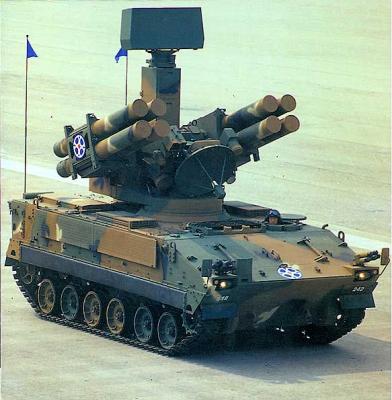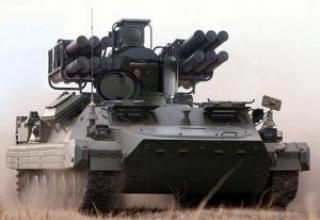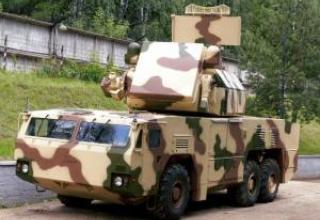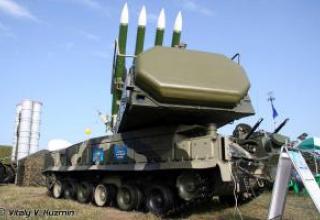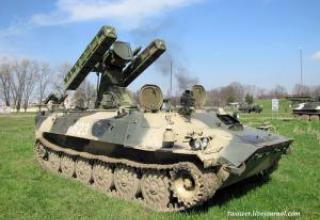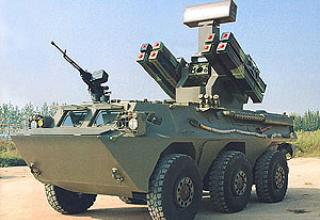Pegasus" ("Chun Ma") complex is designed for air defense of mechanized units of the South Korean Army both on the battlefield and during the march, from attacks of planes, helicopters, cruise missiles, flying at low and extremely low altitudes. The all-weather Pegasus complex can destroy targets day and night in a difficult interference environment.
The complex is created by a consortium of South Korean companies by order of the "Agency for Defense Development" of the Republic of Korea, the main executor of this project is a special "Defense Industry Division" of the "Daewoo" corporation. The starting complex equipment and detection means, similar to those used in the Crotale-NG complex, are supplied by the French firm Thomson-CSF.
The design of the "Pegasus" complex started in 1987, the first two prototypes were tested in early 1996.
There is no information about the adoption of the complex in service.
Composition:
The new all-wheel drive tracked chassis K200A1, used in the Pegasus complex, is the last variant of the range of chassis created by Daewoo Corporation on order of the South Korean army. This chassis accommodates, for example, a 30 mm twin-aircraft defense system such as the Flying Tiger. The K200A1 chassis is slightly longer than previous versions. The Pegasus chassis is armored to protect the crew from shell splinters and bullets. The crew of the complex is 3 persons, the driver is on the left side. In the front of the chassis on the right side there is a 10-cylinder diesel engine "Daewoo" D2840L with an output of 520 hp with automatic transmission, which allows the chassis to reach a speed of 60 km / h. The set of speed from a place to 32 km/h takes 10 seconds. Mileage without refueling is 500 km, the complex has a climb of 60%.
The total weight of the complex is about 25 tons. The chassis is additionally equipped with an auxiliary 43-horsepower engine, as well as a standard set of equipment, including a filter-ventilation unit to protect the crew in case of radioactive contamination of the area, a warning system of firing on the chassis and a smoke screen system.
On top of the chassis is mounted the equipment of the launching complex, which has four missiles in hermetic transport and launch containers on each side of the chassis. In the center is a pulse Doppler surveillance radar E/F-band with a range of target detection up to 20 km. The surveillance radar enables the detection and tracking of up to 8 targets simultaneously. The Pulse Doppler Surveillance Radar mounted below operates in the Ku-band and has a range of 16 km. It is designed to escort helicopters and other targets with the maximum speed up to M=2. Control commands are transmitted on board the missile using a narrow radio receiver.
Both radars carry out an instantaneous tuning of frequency from pulse to pulse. On the left side of the tracking radar there is a FLIR (Forward Looking Infra-Red) thermal imaging system with a detection range of up to 15 km, on the right side there is a TV camera with an IR goniometer operating in daylight hours with a detection range of up to 10 km. IR goniometer is used for initial detection and capture of the launch vehicle, has a field of view of 10 °.
The missile used in the "Pegasus" complex was created by a South Korean consortium on its own and has differences from the rocket complex "Crotale-NG". Solid fuel rocket is made according to normal aerodynamic scheme - four rudders are placed in the tail of the hull. Maximum speed of the rocket is M = 2.6, the maximum effective range is 10 km with the possibility of committing on the far border of the kill zone maneuver with an overload to 30g. The combat unit is a shrapnel-flagged, directional warhead equipped with contact and non-contact laser fuses and provides a high probability of hitting air targets.
All missiles are recharged manually by the crew. The missile guidance operator has a multiscreen panel with color monitors. Computer software of the complex allows to integrate the "Pegasus" complex into any air defense system.
Characteristics:
| Effective range, km | 0.5-10 |
| Defeat height, km | 0.02-6.0 |
| The length of the rocket, m | 2.29 |
| The diameter of the rocket, m | 0.16 |
| Mass of the rocket, kg | 75.0 |
| Weight of combat unit, kg | 12.0 |
| Maximum missile speed, M | 3.6 |
| Recharging time, min | 10 |
Testing:
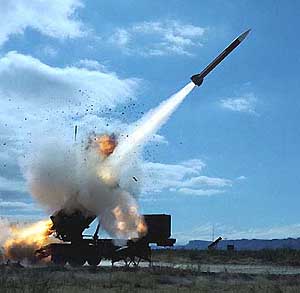
Since 1983, these air defense systems are in service with the U.S. ground forces, were supplied to America's NATO allies, as well as Israel, Saudi Arabia and Japan. The Patriot gained wide popularity during the Gulf War. And not even because it proved to be a reliable means of air defense, but because of skillfully organized advertising campaign. By the way, not a single enemy plane was shot down by them. But the volume of their sales after that war was about $3 billion, according to the manufacturer.
During the war in the Persian Gulf area, Patriot SAMs were used to fight Iraqi tactical missiles Scud. Their use required a warning from a reconnaissance satellite about the launch of the missile and the trajectory of its flight. This data had to be received at least 90 seconds before the warhead appeared on the radar screen. Typically, the interception was performed at altitudes of 5-10 km at a distance of 7-15 km from the battery position. Moreover, the warhead was not always destroyed completely, but only changed its flight path. The target could also be hit by fragments from the destroyed warhead due to the proximity of its interception. In real combat conditions, the effectiveness of the complexes turned out to be twice lower than the results of range tests: the probability of hitting the target was from 0.4 (according to the Soviet General Staff estimates) to 0.6 (according to the Pentagon), against the range of 0.8 - 0.95. In addition, Patriot often killed Scud actually on the ground, at the target, only increasing the damage to the object of attack. This, of course, required a serious improvement of the complex, especially its software. In particular, in addition to the main RAS-1 warhead designed to engage conventional air targets, the RAS-2 warhead was designed specifically to engage tactical ballistic missiles.
The purpose of the Patriot upgrade was to adapt the SAM system to defend small areas against tactical ballistic missile strikes. The objective of this version of the SAM system was not only to ensure that the tactical ballistic missile deviated from the target point, but also to destroy it. To that end, the software was refined, which also made it possible to combine the activities of the 3 Hawk and Patriot SAM systems under common control of a single fire control point. In the course of modernization, the missile's combat unit was improved and a new fuse was installed, the mass of projectiles was increased from 2 to 45 years. These changes did not affect the effectiveness of the missile when shooting at aerodynamic targets and later became standard for all missiles to be upgraded.
The PAC-2 variant was tested at the White Sands test site in November 1987, when a modified Patriot missile was hit by another Patriot missile that simulated the Soviet SS-23 ballistic missile.
As part of the second stage of the RAS-2 modernization, in the early 1990s, the GEM (Guidance Enhanced Missile) program developed a missile with an improved targeting system, including an advanced radio detonator. This improved the combat capabilities of the Patriot SAM system for intercepting the TBR.
At the same time, the QRP (Quick Response Program) provided for modification of the AN/MPQ-53 radar software in order to improve its capabilities when intercepting TBR. According to Reitheon's specialists, this allowed to increase the area defended by Patriot's SAMs against the TBR by 4 times as compared to the RAC-1 option.
Raytheon offers another modernization of the Patriot complex by creating a new version of the missile, designated as RAS-2 direct hit (RAS-2 Hit-to-Kill). The proposal to perform this upgrade is made in order to give the early versions of the system in service a direct hit capability similar to that of the RAS-3 missile, as well as to increase their strike capability.
The upgrade involves the replacement of the passive COS of the existing PAF-2 missiles by the active Ku-band, the replacement of the fragmentation fragmentation warhead and the introduction of a special propulsion system. The missile's software will also undergo modernization. The new components will provide the missile with the ability to manoeuvre during the pointing phase of the target before collision with it, as well as to destroy attacking ballistic or cruise missiles, aircraft and UAVs. The choice of RAS-2 for these purposes is due to its longer range and altitude compared with RAS-3. The use of active CLO can make it possible to implement scenarios of over-the-horizon intercepts.
Together with RAF-3, the Hit-to-Kill rocket could ensure that Patriot systems are in service until 2028. The US Army's SLEP program will include upgrades of the RAF-2 and PAC-2GEM missile variants to the PAC-2GEM+ configuration. This option will include a high-explosive fragmentation warhead, an improved in-flight reprogrammable radio fuse and a surface acoustic oscillator to improve the effectiveness of cruise missile countermeasures.
Sources:
- Chun Ma (Pegasus), Surface-to-Air Missile System
- "Chun Ma"- air defence vehicle
- Василин Н.Я., Гуринович А.Л. "Зенитные ракетные комплексы" .-Мн.: ООО "Попурри", 2002- 464с.
- Surface-to-Air Missile System (K-SAM), Pegasus
